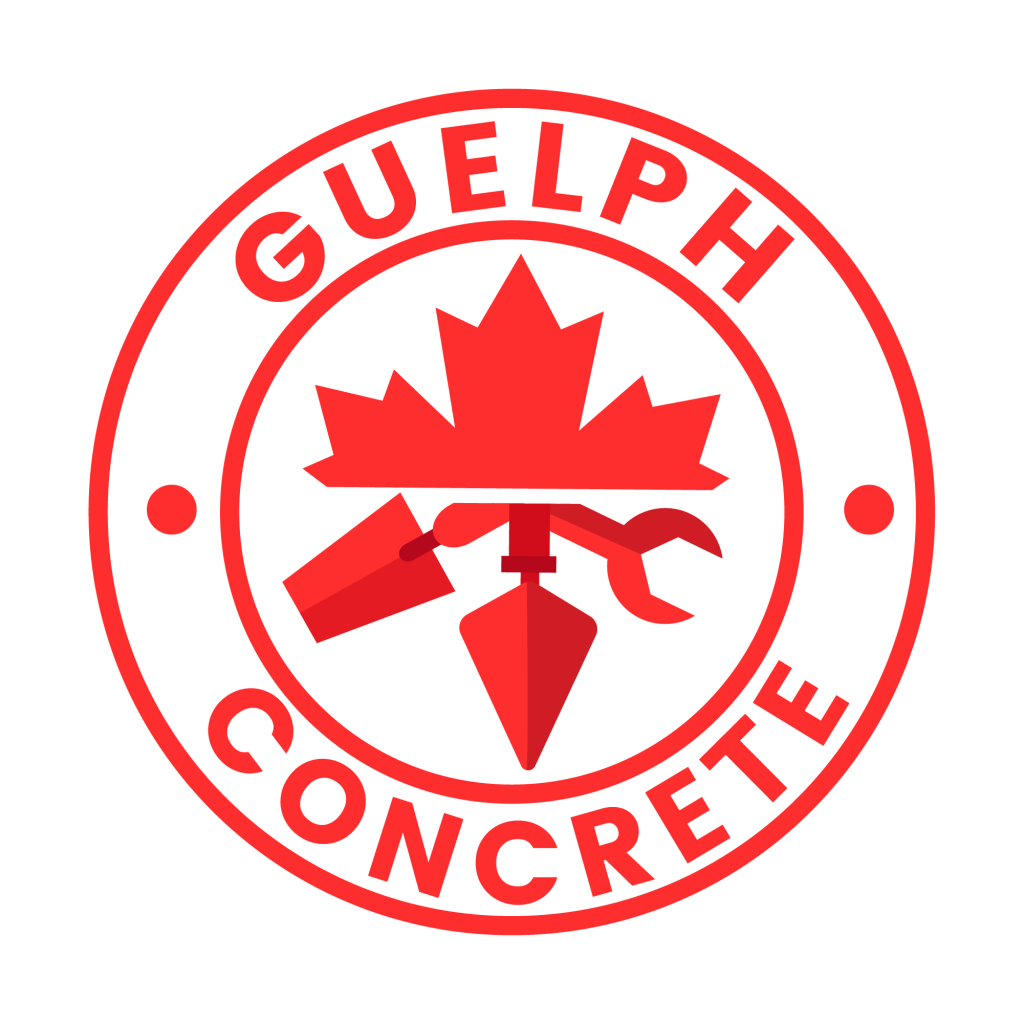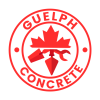At Guelph Concrete LTD, with over 15 years of experience in the industry, we understand the importance of properly waterproofing an ICF foundation in Guelph, Ontario. Our process begins by meticulously cleaning and thoroughly drying the surface to ensure optimal adhesion. We then seal any cracks with high-quality sealant and apply a primer to guarantee strong adhesion.
Utilizing premium materials like Polly Walls Homestretch Peel-and-Stick and Blue Barrier, we expertly apply the membranes, overlapping seams, and pressing firmly with a j-roller. Special attention is given to corners and PVC penetrations using detail tape. We also employ mechanical fastening to ensure everything stays securely in place. Finally, we conduct a thorough inspection to check for gaps and confirm a watertight seal.
For those looking to perfect their waterproofing project, understanding each step in detail is crucial. But why not leave it to the experts? Contact Guelph Concrete LTD for a free estimate and let us handle your waterproofing needs with our proven expertise. Call us today at 548-490-2074.
Understanding ICF Foundations
When we talk about ICF foundations, we’re referring to a construction method that uses insulated concrete forms to create a robust and energy-efficient base for buildings. This approach isn’t just about laying a foundation; it’s about crafting a structure that stands the test of time while keeping our homes cozy and energy bills low.
One of the standout foundation benefits of ICF is its exceptional insulation properties. By using expanded polystyrene or other insulating materials, we can significantly decrease heating and cooling costs. This means a warmer home in winter and a cooler one in summer, fostering a sense of comfort and belonging year-round.
The installation process for ICF foundations is straightforward yet highly effective. We start by stacking the ICF blocks like oversized, sturdy building blocks. Once in place, these blocks are reinforced with steel rebar, adding an extra layer of strength. Finally, we pour concrete into the forms, which then hardens to create a durable, insulated foundation.
Adopting ICF foundations not only enhances the structural integrity of our homes but also supports a sustainable living environment. By choosing this method, we’re investing in a future where our homes are both resilient and energy-efficient, creating a haven for ourselves and our families.
Essential Waterproofing Materials

As we embrace the benefits of ICF foundations, it’s important to understand the key waterproofing materials that guarantee these structures remain dry and resilient in Guelph’s climate. Proper material selection and waterproofing techniques are essential in ensuring the longevity and performance of our ICF foundations.
Let’s explore the necessary materials:
- Polly Walls Homestretch Peel-and-Stick Product: This barrier is applied in vertical 3-foot wide rolls with overlapping seams for enhanced adhesion. It’s a cornerstone of our waterproofing strategy, providing a strong shield against moisture.
- Detail Tape: Used for sealing angles between ICFs and footings, detail tape ensures thorough coverage, addressing vulnerable points where water might penetrate.
- Blue Barrier: This material is applied between the footing and the peel-and-stick barrier, adding an extra layer of protection against water infiltration, which is especially important in Guelph’s variable climate.
- Mechanical Fastening and Proper Sealing: Fastening the top of the peel-and-stick barrier to the ICFs and sealing all connections securely ensures a reliable waterproofing solution. These installation best practices are crucial to maintaining the integrity of our foundations.
Preparing the Foundation Surface
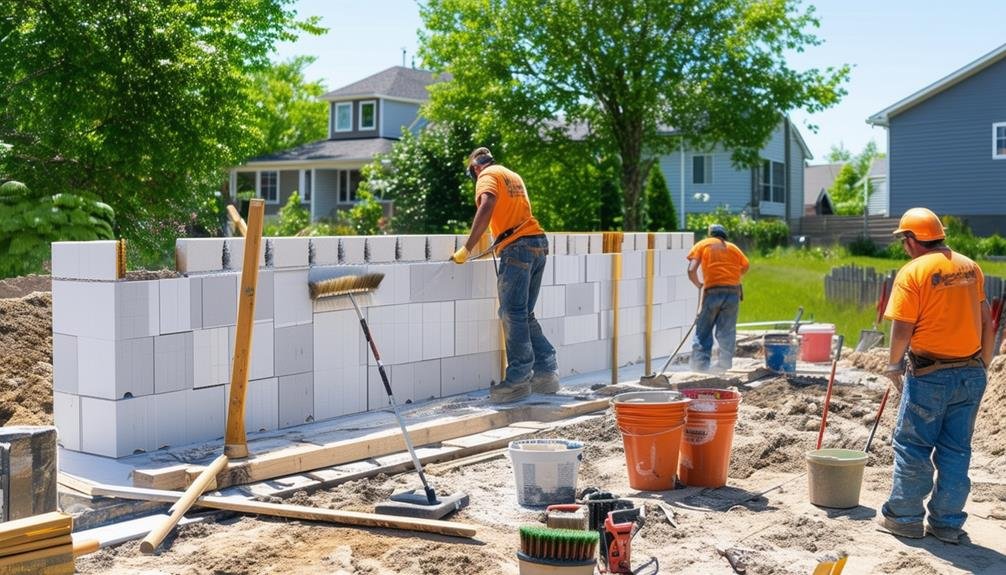
To ensure effective waterproofing, we need to carefully prepare the ICF foundation surface by thoroughly cleaning it to remove any dirt, debris, or contaminants. This essential first step guarantees that our waterproofing products adhere correctly and function effectively. Let’s gather our cleaning supplies and make sure every inch of the foundation is spotless.
Once the surface cleaning is complete, proper drying is vital. Moisture left on the foundation can hinder adhesion, reducing the efficiency of our waterproofing efforts. We can use fans or let the surface air-dry naturally, but let’s not rush this part.
Next, we must inspect the foundation for cracks or gaps. Even the smallest fissures can allow water infiltration, so we’ll use a high-quality sealant to fill them. This step ensures a continuous, unbroken barrier against moisture.
Applying a primer or bonding agent to the ICF surface before the main waterproofing barrier is another significant step. The primer application enhances the adhesion and durability of the waterproofing layer, providing long-term protection. We must also check for any irregularities or imperfections and address them before proceeding. This thorough preparation sets us up for a successful, waterproof foundation.
Applying Peel-and-Stick Membranes
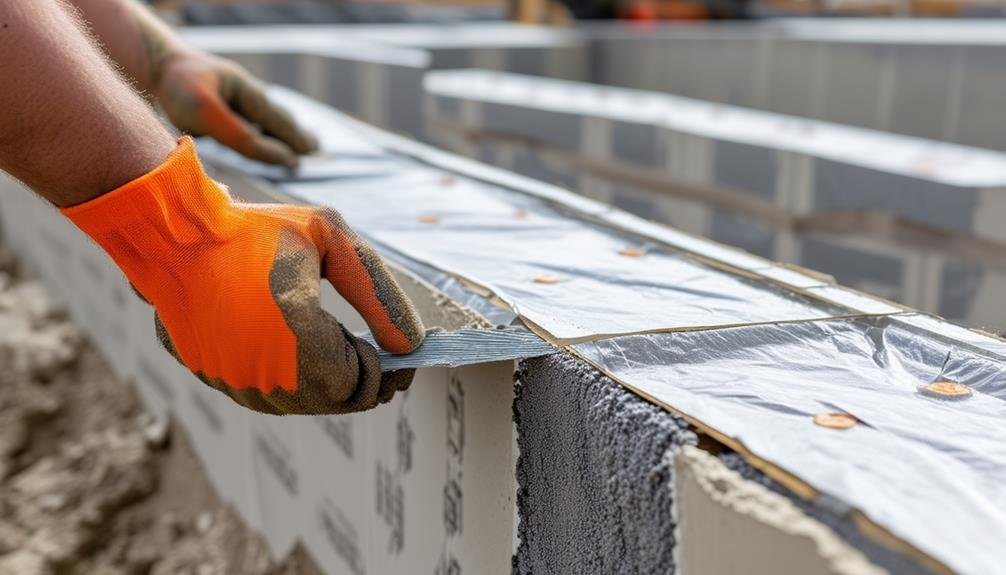
At Guelph Concrete LTD, we take pride in our expertise in applying peel-and-stick membranes to ICF foundations. With over 15 years of experience in the concrete industry, we ensure that every job is done with precision and care.
First, we focus on proper membrane application techniques. Each 3-foot wide roll is applied vertically, and seams are carefully overlapped to guarantee maximum adhesion. We also place special emphasis on sealing critical areas, such as angles and PVC penetrations, to create a tight, waterproof barrier.
If you’re in Guelph, Ontario, and need reliable concrete solutions, Guelph Concrete LTD is here to help. Contact us today for a free estimate at 548-490-2074. Let our experience work for you!
Membrane Application Techniques
When applying peel-and-stick membranes to ICF foundations, we should start by cutting the 3-foot wide rolls into manageable pieces to ensure easier handling and precise installation. This simple step makes the job smoother and helps achieve better membrane adhesion.
Next, we need to apply the membrane vertically along the foundation wall. Using a j-roller, we can press firmly to create a strong bond between the membrane and the ICF surface. Seam overlap is essential here; overlapping seams by at least 3 inches guarantees we get the best waterproofing performance. This overlap acts as a double barrier against water infiltration, giving us peace of mind.
Here’s a quick rundown to keep our process seamless:
- Cutting the Membrane: Slice the 3-foot rolls into shorter, more manageable lengths.
- Vertical Application: Apply each piece vertically, ensuring it adheres correctly.
- Using a J-Roller: Press firmly with a j-roller to enhance membrane adhesion.
- Seam Overlap: Overlap seams by at least 3 inches for optimal waterproofing.
Sealing Critical Areas
Securing a watertight seal in critical areas demands meticulous attention to detail, especially around corners, PVC penetrations, and connections between the foundation and footings. We can’t afford to overlook any part of the process.
For corner sealing, we use detail tape to enhance angle adhesion. The tape guarantees that the peel-and-stick membranes conform perfectly to the angles and corners. When managing roll dimensions, cutting the membrane into shorter pieces makes it easier to handle, reducing the risk of errors. A j-roller is our best friend here, helping us press the membrane firmly against the foundation walls, ensuring no air bubbles compromise the bond.
For PVC penetrations, we need to be extra cautious. Wrapping these areas meticulously with detail tape before applying the peel-and-stick membrane prevents leaks. We finish by securing the barrier with a blue barrier between the footing and membrane, mechanically fastening the top to the ICFs, and sealing connections with a trowel.
Here’s a quick reference table to guide our process:
| Critical Area | Key Technique |
|---|---|
| Corners | Use detail tape for adhesion |
| PVC Penetrations | Wrap with detail tape first |
| Angles | Guarantee proper angle adhesion |
| Roll Management | Cut into shorter pieces |
| Overall Sealing | Use j-roller for strong bond |
Securing and Sealing Techniques

To achieve a durable and watertight ICF foundation in Guelph, Ontario, we must meticulously secure and seal the waterproofing barriers using proven techniques. This approach not only guarantees reliable waterproofing but also extends the foundation’s lifespan through proper waterproofing maintenance.
First, we need to place a blue barrier between the footing and the peel-and-stick waterproofing barrier. This additional layer of protection helps in preventing leaks and forms the foundation of a robust waterproofing system.
Next, we should mechanically fasten the top of the peel-and-stick barrier to the ICFs. This step ensures a firm attachment that won’t loosen over time.
Sealing all connections with a trowel enhances the effectiveness of the waterproofing barrier. Confirming the barrier is tightly attached prevents any drooping or gaps that could compromise the seal. We must also pay close attention to critical areas such as PVC penetrations and corners to maintain a watertight seal.
Here’s a quick checklist to evoke a sense of accomplishment and readiness:
- Use a blue barrier for additional protection.
- Mechanically fasten the peel-and-stick barrier.
- Seal all connections with a trowel.
- Confirm tight attachment to prevent gaps.
Addressing Common Installation Challenges
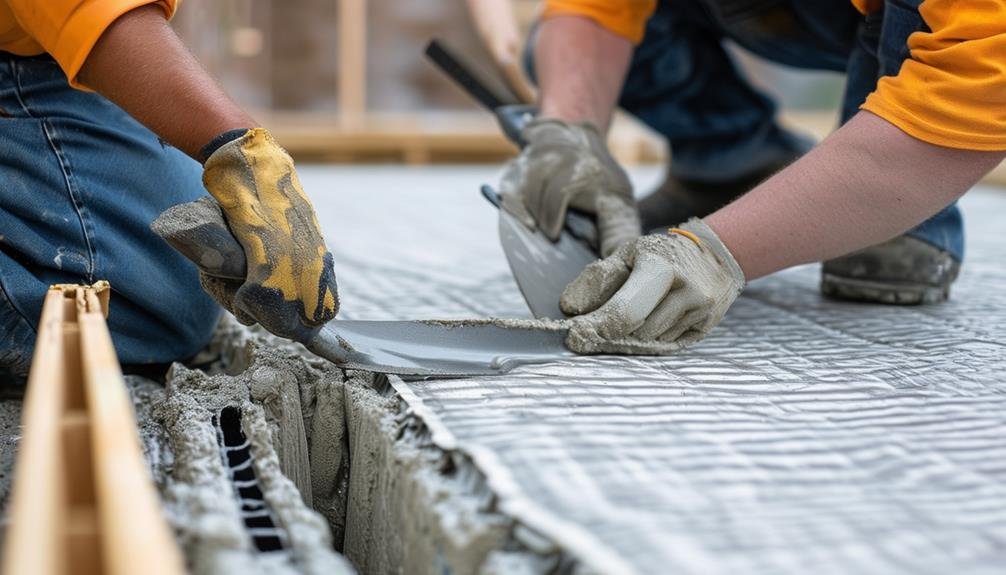
Addressing the common installation challenges head-on is necessary for achieving a flawless waterproofing system for your ICF foundation in Guelph.
One of the primary hurdles we face is guaranteeing proper sealing around PVC penetrations. To tackle this, we need to carefully apply a generous amount of sealant around these areas, making sure no gaps are left.
Corners and angles can be tricky too. Our practical waterproofing tips include using pre-formed corner pieces and making sure that every angle is meticulously sealed. This watertight barrier is vital for long-term protection.
Managing the peel-and-stick rolls‘ length and width can also pose challenges. Cutting them into manageable sections makes the installation process smoother. Using a j-roller is another installation hack we swear by. It guarantees strong adhesion, which is crucial to a secure waterproofing barrier.
Mechanical fastening methods are essential to overcome challenges with attachment. Properly fastening the membrane ensures it stays in place, providing a tight seal. Don’t hesitate to troubleshoot issues as they arise—whether it’s reapplying adhesive or adjusting the positioning.
Evaluating Waterproofing Effectiveness
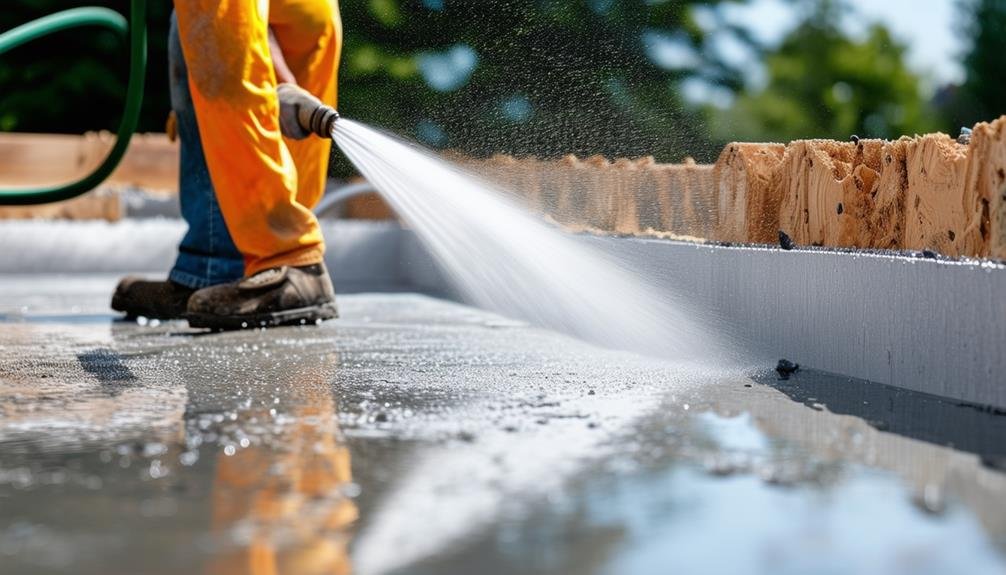
After completing the waterproofing installation, we must carefully inspect every inch to confirm the system’s effectiveness. This step is important to guarantee that our ICF foundation in Guelph, Ontario, stands up to moisture and weather challenges.
Let’s delve into the key tasks for evaluating waterproofing effectiveness:
- Check for Touch-Ups: We begin by looking for any spots that might need additional sealing. Small gaps can lead to significant moisture penetration if left unattended.
- Inspect Sealing and Bonding: Confirm that the waterproofing barrier is securely bonded and sealed across all surfaces. Weak spots in bonding can be prime areas for leaks.
- Examine Connections, Corners, and Angles: These areas are particularly vulnerable. Properly sealed connections and corners are essential to prevent water infiltration.
- Evaluate Overall Effectiveness: Perform a thorough inspection using efficient inspection techniques to ensure the entire system is strong. This complete check ensures quality control and gives us confidence in our waterproofing maintenance.
Frequently Asked Questions
How Do I Waterproof My ICF Foundation?
To waterproof our ICF foundation, we’ll apply exterior sealants and vapor barriers. Inside, we’ll install interior drainage and sump pumps. This guarantees our foundation is protected from water seepage and moisture, providing long-lasting peace of mind.
What Waterproofing System Is Compatible With ICF?
Imagine our ICF foundation as a fortress. To protect it, we combine an exterior drainage system with an interior membrane application. This dual approach guarantees water’s kept at bay, creating a dry, welcoming home for all.
How Do You Waterproof a Block Foundation From the Inside?
We can waterproof a block foundation from the inside by installing an interior drainage system, applying a vapor barrier to the walls, using sealants, and setting up a sump pump. Regular maintenance keeps everything effective.
How Do You Waterproof an Exterior Foundation?
For exterior foundation waterproofing, we should secure superior sealants, ensuring exterior drainage and foundation coatings are correctly applied. Let’s use high-quality membranes, overlap seams, and check for touch-ups to create a community of watertight foundations.
Conclusion
To sum up, waterproofing an ICF foundation in Guelph, Ontario, demands meticulous preparation and the correct materials. By using peel-and-stick membranes and implementing appropriate sealing methods, we can successfully shield our foundations from moisture.
Proactively managing typical installation obstacles assists us in preserving the soundness of the waterproofing. Routine assessments are essential to guarantee long-term efficacy.
With these useful pointers and professional guidance, we’re well-prepared to maintain the dryness and durability of our ICF foundations.

